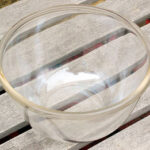How Pyrex was Introduced to the UK
In 1858 Angus and Henry Greener started the Wear Flint Glass Works in Sunderland, but the works did not prosper, and in 1885 they were taken over as a bad debt by James Augustus Jobling, owner of the Tyne Oil and Grease Works in Newcastle.
It was at about this time that a new discovery in glass making had been made in America. The firm of Corning were looking into problems posed by the railroad companies. The lanterns on trains often caused trouble when the glass globes cracked, owing to stress caused by differences in temperature between the flame and any ice or snow, which collected on it. Corning’s eventually produced a special heat-resisting borosilicate glass, which was ideal for the lanterns. This was the birth of PYREX cookware.
People at the time thought it was only suitable for lamp glasses and laboratory ware, until (so the story goes) one of the laboratory workers cut the bottom off a PYREX jar, took it home and asked his wife to test it in her oven as cookware. It was a hugely successful experiment, and PYREX glass is still used in our kitchens today.
James Jobling’s nephew, Ernest Jobling Purser, joined the firm in 1902, and in 1921 he persuaded the company to acquire the patent rights for the production of a heat resistant glass in ‘Great Britain and the Empire (excluding Canada)’, which included Great Britain & Ireland, Australia, New Zealand, South Africa, India and Egypt. The original plain casseroles were an immediate success, and in quick succession many new types and styles of dishes were added. Pie dishes of all sizes, fruit sets and eventually complete dinner sets were all manufactured in clear PYREX glass. Many dishes were sold with silver-plated holders so that they would not look out of place at the dinner table.
To begin with, PYREX products were marketed as labour saving and energy-saving. One 1930s advert (left) even gave a chart showing how much cooking time could be saved by using PYREX cookware.
The advert also points out the delicate pale-gold tinge’ of the PYREX dishes, which would match the housewife’s existing crystal or tinted glass items. This distinctive colour, arising from impurities in the glass, was later eliminated, leaving PYREX glass clear and sparkling.
One of the main advantages of PYREX glass, and an innovation at the time, was the fact that food could be cooked and served in the same dish, thus keeping it warm on the way to the table. This was especially useful to housewives during the war years. The advert on the right shows how to make rations go further by using PYREX cookware. All PYREX glass came with a guarantee against oven-heat breakage.
By 1949, when Ernest Jobling Purser retired, the original half-acre works had increased to six acres, and the workforce had increased from 250 in 1922 to over 1,350.
In 1951, John D. Cochrane joined the company as a designer, and later rose to be Company Director. This was a golden period for Jobling, as Britain recovered from the austerity of the war years. Technological improvements abounded, and the modern housewife clamoured for bright, new designs. Mr Cochrane.
In 1952, Jobling introduced Flameware skillets and saucepans and, in May of the same year, the first coloured PYREX ware was launched, which was also an immediate success.
September 1953 saw a push in advertising PYREX glassware to the housewife. The Spearhead’ campaign addressed this need, as dealers across the country were sent cartons containing six of the most popular and reasonably priced ovenware lines, a small free gift, a window bill, stickers for each piece, and new price lists to pass on to the customer.
Opalware was introduced in 1954. This was a glass that could be heated and then plunged into cold water and was almost unbreakable. The company made tableware for hospitals and other catering establishments.
Caterware was also produced for use in company canteens, so it is often possible to find items showing a company logo. It was so successful that before long it was re-designed and re-named Tableware. During this period, the Jobling six-acre site expanded to an enormous forty acres. By 1955 the workforce stood at 2,400.
In the late 1950s, Corning developed a product called Pyro-ceram, which further resisted breaking and chipping. The body was solid white, and did not have the translucency of Opalware, being more akin to ceramic than glass. This was produced by Jobling as Pyrosil from the 1960s, with an aggressive marketing campaign that claimed the dish would almost wash itself’ after frying boiling or casseroling. Lucky buyers could be entered into a prize draw for the chance to win a 1,000 dream kitchen.
Pyrosil jugs and dishes came with a blue flower design on it, and has attracted its own following of collectors. On the right is a tiny promotional plastic fridge magnet measuring just 2″ across.
Although Jobling had begun making headlamp glasses and traffic signal lenses in the 1930s, by 1960 the factory was concentrating solely on glasses like PYREX and Pyrosil. Every piece of British PYREX tableware ever produced has been made in Sunderland. It is reported that in the period 1946-1958 Jobling production of PYREX domestic wares increased by 94%.
Many changes were seen during the development of the Jobling factory, not least in the transport and distribution of PYREX glass In the September 1955 edition of Jobling’s house magazine, a Mr Kettle recalls that The earliest days of our Transport Department will be remembered, perhaps with some regret, by our older employees, who can recall watching Jimmy Curtis’ horse-drawn cart pull away from the gantry with sparks, froth and language flying – indeed a fearsome sight!’ At the time of writing, the department ran 13 diesel vehicles to deliver their product.
The house magazine of 1961 describes three glass factories on one site in Sunderland at this time, another factory at Pallion (Sunderland), and subsidiary companies at Fenton and Stone (Staffs). There were warehouses at Heywood (Lancs.), West Chirton, and Colnbrook (Slough). There were 2,700 employees at the company, making it the largest employer in the Tyne & Wear area after the shipbuilding yards. The Decorating Department reports that ten million pieces of Opal glassware were produced and decorated in nine months that year.
PYREX ware continued to grow in popularity during the 1960s and 1970s, becoming a regular on wedding lists across the country. However, in 1973, Jobling’s licence expired and Corning took over control of the company, ending the era of Jobling PYREX glass.




